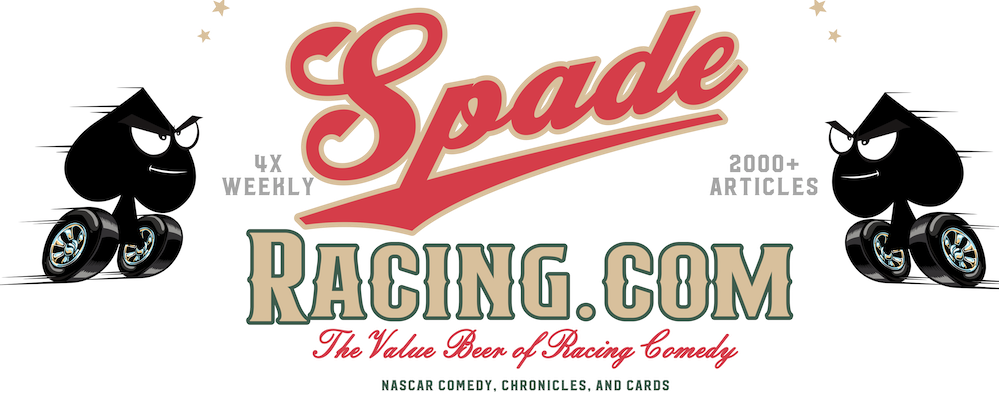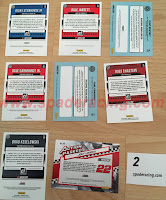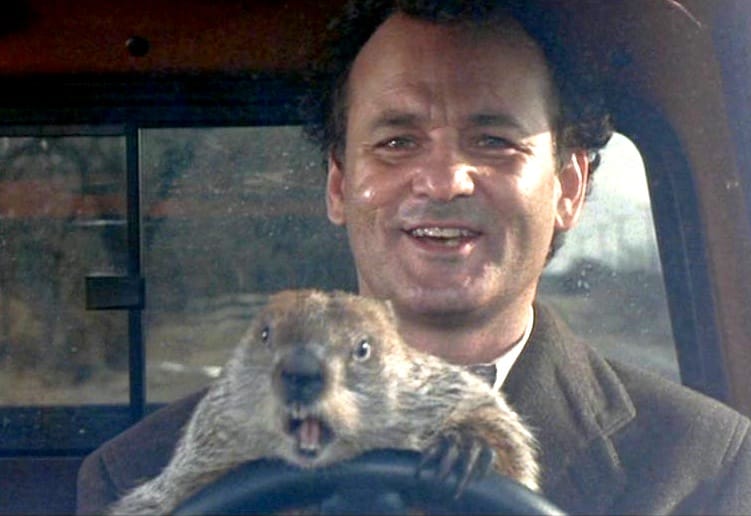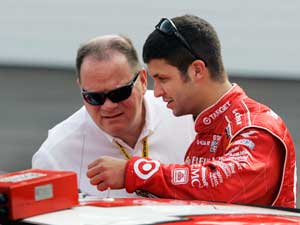NOTE—drivers were judged based on their performance in the Cup Series ONLY, not on performance in other series. Also, while there are some drivers with wins on this list, the way those wins were gained (fuel mileage, plate track) were taken into account. The quality of the rides the drivers had was also factored in, as was any dip in performance of said rides while they were driving there. All statistics are through the end of the 2018 season.
5. PAUL MENARD—1 win in 435+ Cup Series starts. Top teams raced for: Wood Bros. (allied with Penske). Mid-level teams raced for: RCR.
 |
Who knows what impact the relatively
late start to Paul Menard's Cup career
has had on his on-track performance |
Why he’s on here: If we take away the elephant in the room—accusations that the only way he’s been able to sustain his racing career is due to the considerable financial support of his wealthy family business—and look at Menard’s career simply by results, what we have is a journeyman who has yet to show that he can win on more than just a fuel mileage gamble. Menard raced seven years for RCR and while the team was not exactly top-flight, he never posted a single top-ten season points finish. Meanwhile, it was hoped that a move to the Wood Brothers team—now essentially a part of Team Penske—would finally show that he could contend if given the best equipment. Instead he posted a single top-five and finished 19th in points—ten spots lower than Ryan Blaney had done in the 21 car the year before.
Mitigating factors: Menard had a later-than-usual Cup Series debut, running full-time for the first-time in 2007 at age 26. This may not have mattered had he had a start to his Cup career with a better team, but two years with a rapidly declining DEI did him no favors, nor did another two years split between Yates Racing and RPM. While he’s closer to the end of his career than the beginning, he still has time to turn things around under the Penske umbrella.
4. DAVID GILLILAND—0 wins in 333 Cup Series starts. Top teams raced for: None. Mid-level teams raced for: RYR/Yates Racing.
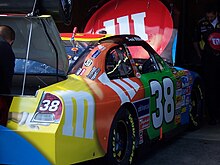 |
One of David Gilliland's
Robert Yates Racing cars |
Why he’s on here: After winning an Xfinity Series race in 2006 for a decidedly low-level team, David Gilliland established himself as one of the hottest free-agents in Nascar. Soon after, he found himself in a solid Cup ride with Robert Yates Racing, and while he failed to impress in his 13-race 2006 rookie year, hopes were high for the future. Unfortunately Gilliland never delivered on the promise of that single Xfinity Series race—outside of plate tracks and road courses he never posted a top-ten in the Cup Series. After the 2008 season he was gone from Yates, eventually finding a home for the low-budget Front Row Motorsports team.
Mitigating factors: RYR/Yates Racing was on its way down before Gilliland got there, and the team soon succumbed to sponsorship departures and became an also-ran. FRM did little to allow Gilliland to show what he could do, meaning that he essentially went his entire Cup career without a shot in truly top-level equipment.
3. SAM HORNISH JR.—0 wins in 167 Cup Series starts. Top teams raced for: Penske. Mid-level teams raced for: RPM.
 |
A hero card from Sam Hornish Jr.'s
time at Team Penske |
Why he’s on here: With three IndyCar championships in tow, Sam Hornish Jr. was transferred to the Nascar Cup Series full-time in 2008 by team owner Roger Penske. For the next three years he did little-to-nothing of note—despite racing for a top-level team, Hornish posted only two top-fives in three full seasons. After attracting criticism for his driving style and failing to finish higher than 28th in the points standings, Hornish was out of the Cup Series after 2010. He would make two brief comebacks—in 2012 again with Penske as a substitute for AJ Allmendinger, and in 2015 for Richard Petty Motorsports—but didn’t come close to contending for wins.
Mitigating factors: The Penske team was arguably in a slump during his three-year stint there, although the cause-and-effect of having an unproductive, inexperienced stock car driver like Hornish there has to be considered. His 2015 comeback came with an RPM team on the way down, and its arguable that the team (which had little steady sponsorship) was barely mid-level.
2. DAVID STREMME—0 wins in 200 Cup Series starts. Top teams raced for: Penske. Mid-level teams raced for: Ganassi.
 |
David Stremme's "unbranded"
Penske Cup car (unofficially
sponsored by Verizon Wireless) |
Why he’s on here: If this list was for most-disappointing drivers across all three of Nascar’s national touring series, Stremme might be number one. Despite frequently showing promise in the Xfinity Series, he never posted a single national touring series win in 250 starts. As for his Cup career, despite running two years for the capable Chip Ganassi Racing team, he failed to impress, finishing 33rd and 24th in points. After a year spent regrouping in the Xfinity Series he returned to Cup with the opportunity of a lifetime—running for Roger Penske. However, Stremme again failed to deliver, posting zero top-ten race finishes and getting released from the ride with three races left in the season. He would race for low-level teams for the rest of his career.
Mitigating factors: Stremme showed improvement of nine places in the final points standings from 2006 to 2007 with Ganassi—2008 could have been a breakout year, but he was released in favor of Dario Franchitti. His time with Penske was arguably at the team’s lowest ebb, as the three-car team posted only two wins the entire year. While its arguable if he “deserved” a third shot in a decent ride, he never received one after his departure from Penske.
1. DANICA PATRICK—0 wins in 191 Cup Series starts. Top teams raced for: SHR. Mid-level teams raced for: None.
 |
Danica Patrick during her ill-fated
year sponsored by Nature's Bakery |
Why she’s on here: Perhaps no driver has entered the world of Nascar with more hype, hope, and hoopla than Danica Patrick did for JR Motorsports (in the Xfinity Series) and Stewart-Haas Racing. A pole in the first race of her first full-time season offered a bit of hope that she could deliver on the promise of the marketing machine behind her. Alas, in five years—all of them with the championship-level SHR team—she posted only seven top-ten finishes and never finished higher than 24th in Cup Series points. After a few short years she was looked at less as a potential star and more of an afterthought, and her departure from the sport after the 2018 Daytona 500 barely registered on a national scale.
Mitigating factors: Throughout her entire career Patrick ran a grand total of TWO races in developmental series (one in K&N East, one in ARCA), arguably stunting her ability to properly develop as a stock car driver. She entered the sport with the most expectations to perform of any driver this side of Dale Earnhardt Jr., and her behavior on and off the track seemed to sometimes show that she was cracking under the immense pressure. Furthermore, the departure of longtime sponsor GoDaddy and the resulting controversy from ersatz replacement Nature’s Bakery likely contributed to her relatively young departure from Nascar.
WHO MISSED THE LIST (and why) in no particular order:
 JJ Yeley
JJ Yeley—if this list was a top-11, Yeley could have been in that spot. He barely misses out on being included due to his lack of a true “second chance” in a decent ride after his two-year stint at JGR.
Scott Riggs—he did little to impress in his five full-time Cup seasons, but he spent them with mid-level equipment at-best with the MBV, Evernham, and Haas CNC teams.
Juan Pablo Montoya—two wins in seven full-time seasons in Cup—both on road courses—isn’t exactly setting the world on fire. However, he was a consistent threat for top-fives and had a career-best 8th-place finish in the points standings in 2009.
Marcos Ambrose—yes, his two Cup wins were both at Watkins Glen, and yes, his near-third win was at Sonoma, but he managed to post top-fives at oval tracks despite running for subpar teams in JTG-D and RPM.
Patrick Carpantier, Christian Fittipaldi, Dario Franchitti—part of a brief craze in which Nascar teams became obsessed with bringing in IndyCar and F1 drivers directly to Cup, none of these drivers did anything of note in stock cars. However, none of them got more than a partial season to prove themselves.
Ty Dillon—while he hasn’t posted a single top-five in 90+ Cup starts, they’ve all either been in substitute roles, part-time rides, or with the lower-level Germain team. Plus, he’s very early into his career.
AJ Allmendinger—his lone Cup Series win in 371 Cup starts was on a road course, but he only had a single shot in truly top-level equipment—his year with Penske that was cut short due to a drug suspension. The rest of his career has been for mid-to-lower-level teams like RPM and JTG-D.
Reed Sorenson—his three year run with Ganassi only showed hints of promise, but after that it was one year with a disintegrating RPM before being stuck in inferior equipment.
Jason Leffler—he had a terrible rookie year with Ganassi (in which he pulled from the car for both road course events), then got a half-season shot with JGR before never again coming close to even a mid-level ride.
Scott Wimmer—he finished third in the first race of his rookie season, then did little else over the next two-plus years. However, he did so with a declining Bill Davis team and a nearly out-of-business Morgan McClure team.
Scott Pruett—the road-racing ace did little in his full-time Cup season in 2000, but did so with the brand-new single-car team of PPI Motorsports. He never got a shot with anything other than a one-off after that.
Brendan Gaughan, Travis Kvapil—neither did much in their rookie seasons with Penske-Jasper Racing, but neither driver got a second chance with a full-time top-flight Cup ride afterwards.
 “Look, everybody here at RWR, from the team owner right down to the janitor/shocks specialist/assistant marketing director, we all know that this isn’t a quick fix”, Kline explained. “We’re all in this for the long haul—if that takes five years or fifty, although I guess if it takes fifty there might be some turnover.”
“Look, everybody here at RWR, from the team owner right down to the janitor/shocks specialist/assistant marketing director, we all know that this isn’t a quick fix”, Kline explained. “We’re all in this for the long haul—if that takes five years or fifty, although I guess if it takes fifty there might be some turnover.”